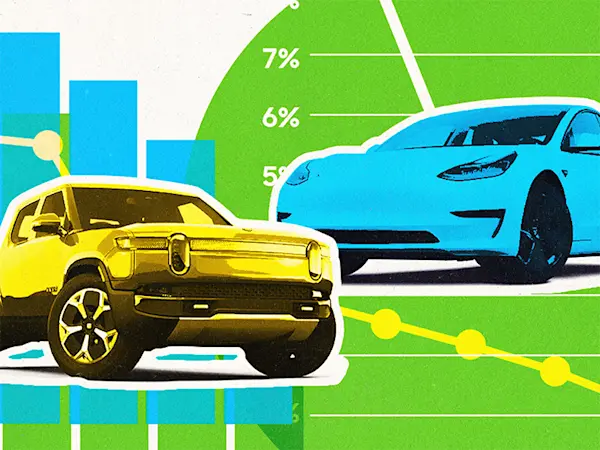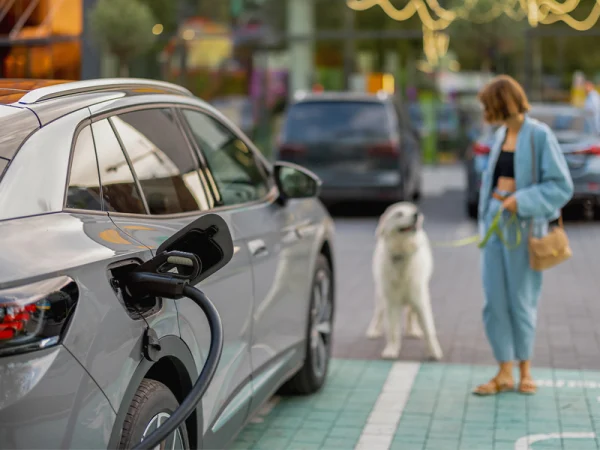2020 Nissan Leaf review
Nissan Leaf highlights
Customer rating
Pros
- Solid range estimates
- Tranquil and peaceful driving experience
- Array of driver assistance features
Cons
- Elevated driver's seat position
- Restricted small-item storage
- Non-flat-folding rear seats limit cargo flexibility
Battery range (EPA estimate)
150 miles
Pricing for current inventory
(no current inventory)
Shop with your budget in mind
Getting pre-qualified lets you shop with personalized monthly payments, and it doesn't impact your credit score.
Great hatchback with electric spirit
Now is a great time to consider electric vehicle (EV) ownership and the Nissan Leaf is one of the pioneers, consistently ranking in our best-of articles. The 2020 Leaf is a great option and comes in a standard version with an EPA-estimated range of 149 miles (S and SV trim) and an optional version, dubbed the "Leaf Plus" (S, SV, and SL trim), with an EPA-estimated range of 215-226 miles depending on trim (all when fully charged).1 The do-it-all Leaf comes in a practical compact five-door hatchback layout and has a lot of standard features. So whether you need a daily commuter or a family hauler for soccer practice, the 2020 Nissan Leaf should be on your list.
All Nissan Leaf years
Not sure what year to select? Learn about each Nissan Leaf generation from 2012 to 2026
What is new for the 2020 Nissan Leaf?
- Trim discontinued: [Specify trim name]
- Standard equipment now includes [list key standard features]
- New equipment added: [list new features or technology]
- Significant removal of [specify any major feature if applicable]
- Improved fuel efficiency with new engine options
2020 Nissan Leaf trims
Curious how Nissan Leaf trims differ? Use our side-by-side vehicle comparison to see the differences and similaritiesS (Standard and Plus):
The base Leaf starts with cloth upholstery, automatic climate control, keyless ignition and entry, an eight-inch touchscreen, Apple CarPlay and Android Auto smartphone integration, proximity key, auto emergency braking front and rear, blind-spot monitoring, rear cross-traffic alert, lane-keep assist, LED taillights, and a rear spoiler.
SV (Standard and Plus):
Adds fog lights, quick charge port, a leather-wrapped steering wheel, six-speaker audio, integrated navigation, satellite radio capability, NissanConnect® EV telematics, and adaptive cruise control
SL (Plus only):
The top-spec Leaf has heated side mirrors, LED headlights and daytime running lights, heated and leather-wrapped steering wheel, six-way power driver's seats with adjustable lumbar, leather seating with heated front seats, rear climate control vents, seven-speaker Bose® audio, cargo cover, auto-dimming rearview mirror, 360-degree camera system, ProPilot® Assist semi-autonomous driving, and a driver alertness monitor
Nissan Leaf photos
5 reasons to buy the 2020 Nissan Leaf
1. Hatchback practicality

The 2020 Leaf comes in a great five-door hatchback layout to help maximize utility. You'll get a generous 23.6 cu-ft of cargo space with all seats in place, which increases to 30 cu-ft of maximum space with the seats folded. So, not only do you get a cool tech-heavy EV, but it's ready for a long weekend as well.
2 . Standard driver aids

Even the base 2020 Leaf S includes Nissan's suite of driver aids. That means standard tech like automatic emergency braking with pedestrian detection, rear automatic braking, rear cross-traffic alert, lane departure warning, blind-spot warning, and high beam assist. So whether you are using it to commute to the office, or trusting a new teen driver with their first vehicle, the 2020 Leaf has you covered.
3. Tech heavy

The technology isn't limited to the EV powertrain. The 2020 Leaf has a well-laid-out eight-inch touchscreen with NissanConnect® technologies built-in. That includes a host of connected tech like Apple CarPlay® and Android Auto™ smartphone integration, Bluetooth® connectivity, as well as three USB ports, and one USB-C port—all standard on the 2020 Nissan Leaf.
4. Quick electric power

The future of transportation doesn't have to be boring. The instant power from the Leaf's electric motor will help you cut through rush-hour traffic with ease. The base version will hit 60 mph in around 7.5 seconds, while the optional Leaf Plus is properly quick at 6.4 seconds to 60 mph (all according to the manufacturer, when new).
5. One-pedal driving

Imagine a driving experience where you press the accelerator to go and let off to stop. The 2020 Leaf features the option to switch between one and two-pedal driving. It's more than just a gimmick, the "e-pedal" function also helps improve your range as well.
Shop with your budget in mind
Getting pre-qualified lets you shop with personalized monthly payments, and it doesn't impact your credit score.
Ratings & reliability
RepairPal gave the Nissan Leaf an overall reliability rating of 4.5 out of 5 stars, which RepairPal describes as Excellent. This rating ranks Nissan Leaf 1st out of 6 among Alternative Fuel Vehicles.
View RepairPal's full rating of the Nissan LeafNissan Leaf features and specs
Curious how Nissan Leaf trims differ? Use our side-by-side vehicle comparison to see the differences and similarities
SV Plus 4D Hatchback 2WD
Standard Features
- Lane Departure Warning
- Cloth Seats
- Smart Key
- Power Windows
- Power Locks
- Power Mirrors
- Rear Defroster
- Blind Spot Monitor
- Air Conditioning
- Side Airbags
- Overhead Airbags
- Traction Control
- ABS Brakes
- Cruise Control
- Rear View Camera
- Parking Sensors
- Alloy Wheels
- Automatic Transmission
- Apple CarPlay
- Android Auto
- Satellite Radio Ready
- AM/FM Stereo
- Navigation System
- Bluetooth Technology
- Auxiliary Audio Input
- Cloth Seats
- Front Seat Heaters
- Power Seat(s)
- Lane Departure Warning
- Automated Cruise Control
- Heated Steering Wheel
- Heated Mirrors
Drive Wheels
Front Wheel Drive (2WD)
Engine size
0.0L
Engine type
Electric
Wheelbase
106.3"
Overall length
176.4"
Width
70.5"
Height
62"
Leg room
F 42.1"/R 33.5"
Head room
F 41.2"/R 37.3"
Front tires
P215/50VR17
Rear tires
P215/50VR17
Seating capacity
5
Transmission
Automatic
2020 Nissan Leaf FAQ
No, the Leaf is a compact five-door hatchback battery electric vehicle (BEV). It's available in front-wheel-drive only and the shape lends itself nicely to city driving. It might not be as spacious as an SUV, but the maximum 30 cu-ft of cargo space is plenty for around-town errands and weekend getaways.
The base 40 kWh version will hit 60 mph in around 7.5 seconds, while the optional Leaf Plus and its 62 kWh setup is a bit quicker at around 6.4 seconds to 60 mph—according to the manufacturer, when new. You also get off-the-line acceleration thanks to the electric motor's instant torque.
No, the 2020 Nissan Leaf and the optional Leaf Plus are both front-wheel-drive vehicles. There are currently no all-wheel-drive Nissan Leafs out there.
More about the 2020 Nissan Leaf
Color options

Exterior colors:
Brilliant Silver Metallic
Deep Blue Pearl
Glacier White
Gun Metallic
Pearl White TriCoat
Pearl White TriCoat/Super Black (Two-tone)
Scarlet Ember Tintcoat
Sunset Drift ChromaFlair®
Super Black
Interior colors:
Black Cloth (S and SV)
Black Leather (SL)
Light Gray Leather (SL)
Interior details
The 2020 Nissan Leaf features standard interior features like cloth upholstery, an eight-inch touchscreen, automatic climate control, 60/40 split-folding backs, and more. The 2020 Leaf has 23.6 cu-ft of cargo space with all seats in place, which increases to 30 cu-ft of maximum storage space with the seats folded.
Child seat details
The 2020 Nissan Leaf has two full sets of LATCH connectors for securing child car seats on the driver and passenger side with one additional seating position in the middle with a tether anchor only. This makes it suitable for a range of different car seat types.
Performance
The base 40 kWh 2020 Nissan Leaf has 147 hp and will hit 60 mph in around 7.5 seconds, while the optional Leaf Plus—with its upgraded 62 kWh battery and powertrain with 214 hp—will get there around 6.4 seconds (when new).
The base S trim with the 40 kWh setup starts at an EPA-estimated 149 miles of electric range on a full charge and an EPA-estimated 111 MPGe combined, while that number drops a bit to an EPA-estimated 108 MPGe combined for the 62 kWh battery on the base trim.
, Both of the optional SV and SL trim levels with 62 kWh power get an EPA-estimated 104 MPGe combined and an EPA-estimated of 226 miles of electric range on a full charge.,Year comparison
2011-2017 Nissan Leaf (first generation)
The Nissan Leaf went on sale for the 2011 model year and represents one of the first mass-produced all-electric cars. The Leaf has always been a five-door hatchback and all model years are front-wheel drive. Early versions used a smaller 24 kWh lithium-ion battery pack with an EPA-estimated 99 MPGe and a real-world driving range of 70 to 100 miles on a full charge.
, The trip to 60 mph took around 9.7 seconds, so it wasn't as quick as newer EVs.However, Nissan continued to add features and trim levels across the first generation. A new base trim, the S, was added for 2013, and for 2014 a standard backup camera was added to all trim levels. After some light updates for 2015, Nissan added a bigger battery pack and a larger (five-inch) standard touchscreen for the 2016 model year. 2017 was the last year of the first generation, but Nissan still upgraded the battery packs again, now up to 30 kWh, which gave all Leaf trim levels an EPA-estimated 107 miles of range on a full charge.
2018-Present Nissan Leaf (second generation)
The Leaf was all-new for 2018 with a fresh new design and better EV tech underneath. For 2018, only a 40 kWh battery pack was available, which powered an electric motor with 147 hp. Standard features included things like a seven-inch driver's display screen, automatic temperature control, and more.
Notably, for 2019 the more powerful, and longer-range Leaf Plus model was added featuring a 62 kWh battery. 2020 saw standard tech upgrades like an eight-inch infotainment display with Apple CarPlay and Android Auto connectivity. Knee and side-impact airbags also became standard across all trims for the 2020 model year. After no significant changes for 2021, Nissan added a level 3 fast-charging port to all Leaf models for 2022.
Research other vehicles
- nissan leaf used car value
- 2011 nissan leaf used car value
- 2012 nissan leaf used car value
- 2013 nissan leaf used car value
- 2014 nissan leaf used car value
- 2015 nissan leaf used car value
- 2016 nissan leaf used car value
- 2017 nissan leaf used car value
- 2018 nissan leaf used car value
- 2019 nissan leaf used car value
- 2020 nissan leaf used car value
- 2021 nissan leaf used car value
- Used Nissan Leaf near me for sale
- Used 2020 Nissan Leaf near me for sale
- Used 2023 Nissan Leaf near me for sale
- Used Black Nissan Leaf near me for sale
- Used Blue Nissan Leaf near me for sale
- Used Gray Nissan Leaf near me for sale
- Used Nissan Leaf with Navigation System near me for sale
- Used 2021 Nissan Leaf S Plus near me for sale
- Used Nissan Leaf SV Plus near me for sale
- Used White Nissan Leaf near me for sale
- 2021 Audi RS5 review
- 2022 Audi RS5 review
- 2023 Audi RS5 review
- 2022 BMW i4 review
- 2023 BMW i4 review
- All things EV
- 2023 Mercedes-Benz E63 AMG review
- 2025 Mercedes-Benz EQB 250 review
- 2024 Mercedes-Benz EQB 250+ review
- 2025 Nissan Leaf review
- 2012 Nissan Leaf review
- 2015 Nissan Leaf review
- 2016 Nissan Leaf review
- 2018 Nissan Leaf review
- 2021 Nissan NV 1500 review
- 2021 Nissan NV 200 review
- 2021 Nissan NV 2500 review
- 2020 Porsche Cayenne Hybrid review
- 2018 Porsche Cayman review
- Ram 2500
We hope you found this information helpful. This content is intended to inform and is not meant to indicate that a particular vehicle is currently available or recommended for you.
Statements of fuel economy or EV range are based on EPA and other third-party estimates for vehicles when new. Fuel economy and EV range will degrade with time and vary based on age, driving conditions, vehicle history, and other conditions. See fueleconomy.gov for more info.
Unless otherwise noted, information related to featured vehicles comes from third-party sources, including manufacturer information. Product and company names may be trademarks or registered trademarks of third-party entities. Use of them does not imply any affiliation with or endorsement by these entities. By clicking on any video links, you will be taken to a third-party site maintained by YouTube, Inc.
We make every effort to provide accurate information, but please verify before purchasing.









